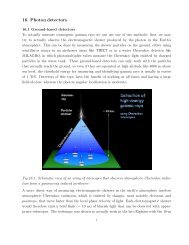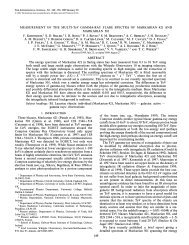Gamma-Rays Produced in Cosmic-Ray Interactions and TeV-band ...
Gamma-Rays Produced in Cosmic-Ray Interactions and TeV-band ...
Gamma-Rays Produced in Cosmic-Ray Interactions and TeV-band ...
Create successful ePaper yourself
Turn your PDF publications into a flip-book with our unique Google optimized e-Paper software.
of cosmic-ray electrons must be expected, though [4, 44]:<br />
Electrons are accelerated by<br />
SNR with power-law spectra of <strong>in</strong>dex -2.0 or similar, but severe energy losses prevent them<br />
from homogeneously fill<strong>in</strong>g the Galaxy. A hard spectral component from <strong>in</strong>verse Compton<br />
scatter<strong>in</strong>gs could then expla<strong>in</strong> the GeV bump <strong>in</strong> the diffuse γ-rays. It has also been argued<br />
that both a harder electron <strong>and</strong> a harder nucleon spectrum may be required to reproduce<br />
the GeV excess [12].<br />
Figure 6 shows the observed GeV-b<strong>and</strong> γ-ray emission from the <strong>in</strong>ner Galaxy <strong>in</strong> comparison<br />
with the contributions from π 0 decay as well as bremsstrahlung emission, which we<br />
here describe by a power-law spectrum<br />
ω e<br />
Φ B (E) ≃ 1.3 × 10 −8<br />
0.1 eV/cm 3 ·<br />
(<br />
N ISM<br />
10 22 cm · −2<br />
E<br />
100 MeV<br />
) 2.0−Γe erg<br />
cm 2 sec sr<br />
with power-law spectral <strong>in</strong>dex Γ e = 2.1, the electron energy density ω e =<br />
0.1, 0.4, 0.8 eV/cm 3 , <strong>and</strong> the gas column density N ISM = 3 ×10 22 , 8 ×10 21 , 3 ×10 21 cm −2 ,<br />
respectively. The generat<strong>in</strong>g cosmic-rays are assumed with an energy density ρ E =<br />
0.75 eV/cm 3 . Models based on the locally observed cosmic-ray spectra generally predict<br />
a softer spectrum for the leptonic components, even after account<strong>in</strong>g for <strong>in</strong>verse Compton<br />
emission [6], so we may <strong>in</strong> fact overestimate the GeV-b<strong>and</strong> <strong>in</strong>tensity of the leptonic<br />
contribution. Nevertheless, it is clearly seen <strong>in</strong> this figure, that <strong>in</strong> the total <strong>in</strong>tensity an<br />
over-shoot<strong>in</strong>g around E γ ≃<br />
(11)<br />
300-600 MeV appears <strong>in</strong> the modelled γ-ray energy distribution,<br />
whereas a deficit is present above 1 GeV. The observed spectrum of diffuse emission<br />
is always harder than the model spectrum, <strong>and</strong> we therefore conclude that an <strong>in</strong>accurate<br />
description of hadronic γ-rays is ruled out as the orig<strong>in</strong> of the GeV excess, <strong>in</strong> l<strong>in</strong>e with earlier<br />
work [9].<br />
IV. THE TEV-BAND SPECTRUM OF RX J1713-3946<br />
As SNR’s are believed to be the ma<strong>in</strong> sources of Galactic cosmic rays, it is worth test<strong>in</strong>g<br />
whether or not the observed γ-ray spectra from SNR can be well modelled <strong>in</strong> terms of<br />
hadronic <strong>in</strong>teractions. The γ-ray production matrix presented <strong>in</strong> this paper is a valuable<br />
tool <strong>in</strong> such an analysis.<br />
The HESS collaboration has measured the <strong>TeV</strong>-b<strong>and</strong> gamma-ray spectrum of the shelltype<br />
SNR RX J1713.7-3946 over more than two decades <strong>in</strong> energy <strong>and</strong> <strong>in</strong> approximately ten<br />
13







